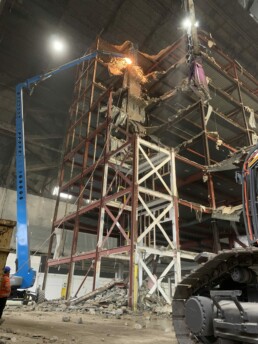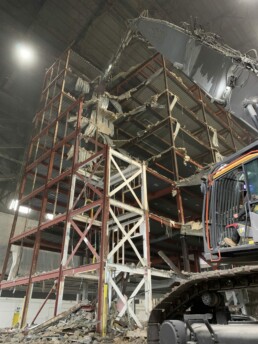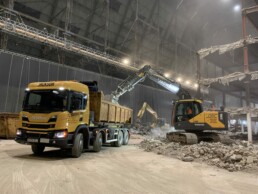8 Storey Steel Frame Removal at Cardington Hanger, Bedford
SCOPE:Removal of a 8-storey steel frame, concrete structure and attached mezzanine floors & stores buildings
Share
This project was the removal of a redundant 8 storey steel frame and concrete structure built inside the hanger and used in the 1970s and 1980s for gas explosion experiments and for investigating fires.
Some of the higher level concrete floors had suffered fire damage during this research and were unstable. Sections of the steel frame had suffered heat deflection.
The close proximity of the listed hanger walls and roof structure added further complications to this challenging project.
History
RAF Cardington was constructed by aircraft manufacturing company Shorts Brothers to build airships for the Admiralty.
Two large hangers were built at the site. Shed 1 was built in 1915 and No. 2 shed which had originally been located at RNAS Pulham, Norfolk, was dismantled in 1928 and re-erected at Cardington.
After the crash of the R101, in October 1930, all work stopped in Britain on airships. Cardington then became a storage station and in 1936/1937 Cardington started building barrage balloons.
For both airships and barrage balloons, Cardington manufactured its own hydrogen gas and produced all the gases used by the RAF.
Standing 55m high, 247m long and 84m wide the cavernous Grade 2 listed hanger is now a film studio and has hosted the production of several Batman films and many other movie projects.
The current owners of the site are regular clients of C. Jackson & Sons. We have carried out numerous asbestos removal and demolition contracts across their portfolio of properties and businesses over the last 15 years.
Incidentally C Jackson & Sons demolished and removed the large gas storage tank from the site in 1994
After removal of the attached mezzanine floors and stores buildings, the substantial 35m high structure was brought down using a 90 tonne, 40m high reach excavator fitted with a 3.5 tonne cutting shear.
Dust was controlled using fine mist water jets fitted to the high reach excavators and additional water sprays that were delivered from high access MEWP boom lift platforms.
Lower levels were demolished by our 50 tonne excavator fitted with a 5 tonne cutting shear with support from smaller 25 tonne, 15 tonne excavators & wheeled shovels which were used for primary processing and loading materials.
In total 750 tonnes of scrap metal, timber and plasterboard were recovered and sent for recycling.
2,500 tonnes of concrete arisings were crushed on site to 6f2 grading using our 50 tonne tracked crusher.
The work was finished within the 6 week programme and on budget.
As part of our follow on civil engineering works package, we constructed new roads and car parks using the crushed concrete recovered from the demolition works as roadstone.



